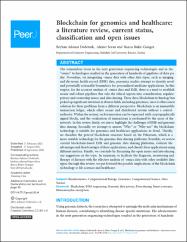| dc.contributor.author | Dedeturk, Beyhan Adanur | |
| dc.contributor.author | Soran, Ahmet | |
| dc.contributor.author | Bakir Gungor, Burcu | |
| dc.date.accessioned | 2021-11-28T08:35:57Z | |
| dc.date.available | 2021-11-28T08:35:57Z | |
| dc.date.issued | 2021 | en_US |
| dc.identifier.issn | 2167-8359 | |
| dc.identifier.uri | https //doi.org/10.7717/peerj.12130 | |
| dc.identifier.uri | https://hdl.handle.net/20.500.12573/1049 | |
| dc.description.abstract | The tremendous boost in the next generation sequencing technologies and in the "omics"technologies resulted in the generation of hundreds of gigabytes of data per day. Nowadays, via integrating -omics data with other data types, such as imaging and electronic health record (EHR) data, panomics studies attempt to identify novel and potentially actionable biomarkers for personalized medicine applications. In this respect, for the accurate analysis of -omics data and EHR, there is a need to establish secure and robust pipelines that take the ethical aspects into consideration, regulate privacy and ownership issues, and data sharing. These days, blockchain technology has picked up significant attention in diverse fields, including genomics, since it offers a new solution for these problems from a different perspective. Blockchain is an immutable transaction ledger, which offers secure and distributed system without a central authority. Within the system, each transaction can be expressed with cryptographically signed blocks, and the verification of transactions is performed by the users of the network. In this review, firstly, we aim to highlight the challenges of EHR and genomic data sharing. Secondly, we attempt to answer "Why"or "Why not"the blockchain technology is suitable for genomics and healthcare applications in detail. Thirdly, we elucidate the general blockchain structure based on the Ethereum, which is a more suitable technology for the genomic data sharing platforms. Fourthly, we review current blockchain-based EHR and genomic data sharing platforms, evaluate the advantages and disadvantages of these applications, and classify these applications using different metrics. Finally, we conclude by discussing the open issues and introducing our suggestion on the topic. In summary, to facilitate the diagnosis, monitoring and therapy of diseases with the effective analysis of -omics data with other available data types, through this review, we put forward the possible implications of the blockchain technology to life sciences and healthcare. | en_US |
| dc.language.iso | eng | en_US |
| dc.publisher | PEERJ INC341-345 OLD ST, THIRD FLR, LONDON EC1V 9LL, ENGLAND | en_US |
| dc.relation.isversionof | 10.7717/peerj.12130 | en_US |
| dc.rights | info:eu-repo/semantics/openAccess | en_US |
| dc.subject | Blockchain | en_US |
| dc.subject | DNA sequencing | en_US |
| dc.subject | Genomic data privacy | en_US |
| dc.subject | Data sharing | en_US |
| dc.subject | Smart contracts | en_US |
| dc.subject | Homomorphic encryption | en_US |
| dc.title | Blockchain for genomics and healthcare: a literature review, current status, classification and open issues | en_US |
| dc.type | review | en_US |
| dc.contributor.department | AGÜ, Mühendislik Fakültesi, Bilgisayar Mühendisliği Bölümü | en_US |
| dc.contributor.institutionauthor | Dedeturk, Beyhan Adanur | |
| dc.contributor.institutionauthor | Soran, Ahmet | |
| dc.contributor.institutionauthor | Bakir Gungor, Burcu | |
| dc.identifier.volume | Volume 9 | en_US |
| dc.relation.journal | PEERJ | en_US |
| dc.relation.publicationcategory | Diğer | en_US |


















